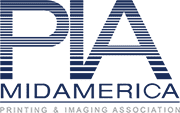Kansas City Celebrates 125 Years of Association
In the spring of 1887, a handful of printers came together to create an organization which would “develop and foster a kindly feeling among master printers, and improve the printing industry.” The organization was called the Typothetae of Kansas City, and that same year printers from similar organizations from all over the
It was a tumultuous time in the
Sixty-eight delegates attended the meeting representing 18 Master Printers’ Associations and four individual printing firms from 22 cities. The delegates adopted a constitution on the third day of the convention. The preamble of the constitution stated: “With a view of developing a community of interest and a fraternal spirit among the Master Printers of the United States and the dominion of Canada, and for the purposes of exchanging information and assisting each other where necessary, the typothetae and other societies of employing printers of various cities, through their authorized delegates, do hereby organize themselves into a national association,” which we now call Printing Industries of America.
Over the next twenty years, the
In 1911 the organization incorporated and became the Kansas City Graphic Arts Organization, at that point in time it was considered to be the largest branch of the United Typothetae (“Inland Printer” [Vol 48, October 1911]). Up to 1919 the organization was primarily volunteer driven. That changed right after World War I when Oliver Wroughton, the Association’s first employee was hired. Wroughton was an attorney and instrumental in developing a variety of programs including credit programs between printers and “supply men,” as well as acting as an agent in labor negotiations. Wroughton served as the Association’s executive director through the next 32 years and another world war.
Post World War II was a very different time. Prior to this time, the industry (like many manufacturers) had struggled through the Depression and then dealt with strict rationing and price controls during WWII. Because of the craft mentality of the industry and the powerful International Typographer’s Union (ITU), labor issues, while not as combative as in the past, were still of concern to the industry. Thus, it comes as no surprise that the next employee hired by the Association was an attorney as well. His name was Burdette Yeo. Yeo would serve the Association for the next 18 years as it grew with
Since industrial relations was a critical part of the Association’s services, in 1956 the Association sponsored a health and welfare program for its members. This program was highly successful in lowering benefit costs and also provided non-dues revenue for the organization. This program was a key offering of the Kansas City Association until 1990 when the industry’s labor unions introduced their own programs.
In 1958, the Kansas City Graphic Arts Association made another name change reflecting the changing industry demographics. For the next 36 years the organization would be called the Printing Industries Association of Kansas City.
When 1970 arrived, lithography was becoming the dominant printing technology and the days of Linotypes and hot metal was beginning to be relegated to the past. High-speed offset web presses were being introduced across the
As the ‘80s approached, the industry was beginning to see different challenges on the horizon. Industrial Relations started to take a back seat to wide-reaching regulatory bodies which began affecting printers across the
Once again the Association took a lead in assisting its members. A unique partnership with OSHA was created and the end result was one of the industry’s first comprehensive safety documents created with a grant from OSHA. Prior to this effort, James Oldebeken was added to the staff and he would take the reins from Ray in 1994 and would serve as its executive director until the creation of PIA MidAmerica in 2001.
Over the years,
